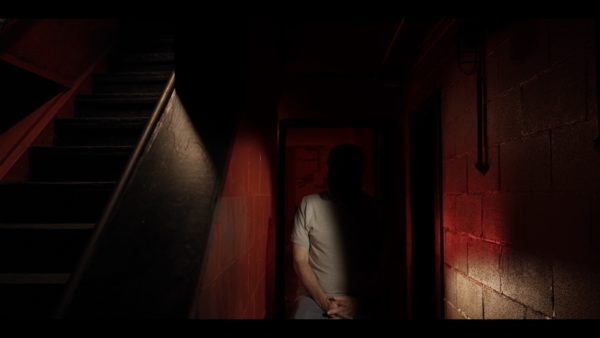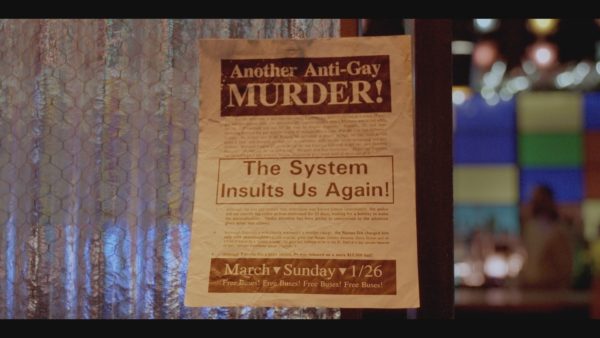
Each week, Terry and Joe discuss HBO’s true-crime docuseries Last Call: When a Serial Killer Stalked Queer New York.
Spoilers follow for Episode 2…
Missed a Review? Episode 1
Episode 2: A third victim is part of the world of the queer community’s most vulnerable population: sex workers of color. While the AVP is pressuring the NYPD and the media to connect the murders, another piece of evidence leads investigators to Staten Island.
TERRY
Episode 2 starts with an incredibly horrifying scenario, Joe. One that is so real in its simplicity but nightmarish in execution. We have the offscreen director of the segment asking about “the night you met this man with a canvas bag.” The screen turns to an Anonymous Man standing by a staircase, his features bathed in darkness.
He recalls an evening at the Five Oaks, a very popular piano bar, when a man bought him a drink at the bar. The man had what he referred to as a “gym bag” but didn’t look like any gym bag this Anonymous Man could recall. After having the drink, he felt immediately wrong and started stumbling home when the Man with the Bag offered to help him.
What follows is a brief home invasion that’s stopped because the Anonymous Man saw rope in the canvas bag and ended up outsmarting him and getting him outside the apartment.
Talk about a horrific encounter, particularly given what we know so far about this serial killer. From this opening, the time jumps forward to Ocean County, NJ in 1993 where more body parts are discovered. Former Ocean City Detective Mike Mohel says “Right away we thought of the Mulcahy body” from the first episode. This victim was Anthony Marrero, someone who was the exact opposite of the previous two murders.
They were rich, white men while Anthony was poor, a person of color, and a sex worker. That’s an important set of distinctions, because, like in the first episode, Last Call uses the murders as a jumping off point to discuss institutional homophobia and the indifference towards the queer community in NYC.
Bea Hanson and Matt Foreman return from the first episode to provide historical context from their vantage point as members of the Anti-Violence Project (AVP). Bea explains that Anthony was treated differently from the previous two murders, both from the police attention as well as the media attention. They were presented as married, rich men while Anthony was reduced to his occupation. She continues, explaining how race, sex work, trans people put people in a different category within the broad grouping of homophobia.
“Gay hate crimes were never written about, unless we made a huge fuss about it,” Bea ultimately says and various advocacy groups like Pink Panthers, ACT UP, Queer Nation, AVP, Lesbian Avengers and the like all started standing up, showing the world crimes that had happened over the weekend and demanding people do something about it.
These queer groups standing up is contrasted with Anita Bryant’s campaign to take away queer rights as well as the religious institutions who were demonizing the community. Used together, Last Call showcases the stark reality of the tensions and the horrors the queer community was already dealing with, even without a killer.
I’m curious what you thought of this episode, Joe. Did the harrowing opening terrify you as much as it did me? Do you like the mix of the historical context and the focus on the crime, or is it swinging too hard one direction? Along with the historical context, Episode 2 gave us more family and friends of the victims. Did the contrast between Anthony’s brother and Anthony’s great newphew and their relationships to the queer community work for you?
JOE
It’s a big, bold swing to open and close the episode with the Anonymous Man, Terry. Thus far Last Call has been pretty consistent in identifying its talking heads and/or interview subjects, so I wasn’t sure about the context for using an anonymous figure.
We never do learn why the man refuses to identify himself, but it ultimately matters less than his story, which ends with a close call that he never reports to the police. If episode one introduced the idea of the queer community at odds with law enforcement tasked with protecting them, this second episode really lays into the NYPD. Multiple interviewees observe and/or lament how the NYPD resisted efforts to work with both the community and other law enforcement to collect witness statements or even notify them of the serial killer in their midsts.
It sounds wrong to say, but I was really appreciative of the increased focus in this episode on POC and sex work. The first episode presented one very distinct type of gay man: white, affluent, and closeted, but that’s hardly representative of all gay men. Anthony Marrero is a completely different type of queer and it’s clear that his death was handled differently from Anderson and Mulcahy.
Sidebar: the docuseries continues to do stellar work including interviewees who don’t always say the right thing and Jose Luis Marrero, Anthony’s older brother, is a great example of someone who loved a victim, but also resolutely refuses to acknowledge their lived experience (in this case in sex work).
My favourite part of the episode, besides the introduction of Ceyenne Doroshow, who I’ll talk about more in a moment, is the historical overview of the Red Light district of NY in the early 90s. As someone whose entire knowledge of these times comes from films like Cruising or other documentaries, it’s absolutely fascinating to see the footage of the sleazy sex shops, the street corners, and the leather bars between the Port Authority bus terminal and Times Square. We’re told that this is where business people and tourists would intermingle with sex workers, johns, pimps, drug addicts, and the like. It’s a far cry from the sanitized version of that area that occurred shortly after all of these murders happened when the city demanded it be cleaned up for tourism.
It’s here that Anthony would work, alongside his friend Ceyenne. And whoo boy, after some pretty stoic and serious talking heads, does Ceyenne feel like a breath of fresh air! It’s not just that the former sex worker, activist and friend of Anthony’s is candid and entertaining – she presents a completely different perspective from other people.
While Jose Luis provides a distinct generational perspective on his brother and young Antonio laments not knowing the “real” Anthony, Ceyenne knew him well. The story she tells of bringing Anthony back to her place after a bender so that he could sleep, buy new socks and underwear, recharge his batteries and eat a good meal is a small, intimate story that roughs completely counter to the salacious, derogatory portrait of the man in the press after his body is discovered.
For me this is still the best and most compelling part about Last Call: its careful presentation of the victims as human beings, not just outsiders or statistics.
Terry back to you: what were your thoughts on Ceyenne? How are you finding the balance between the victims’ backstories and the police procedural this week? And following “Pick Up Crimes” last week and this week’s definition of “Overkill”, do you feel like you’re expanding your queer lexicon of violent crime terminology and statistics?

TERRY
Ceyenne was a huge get for the show, Joe. I’ve only been tangentially familiar with Ceyenne, but know that GQ called her “the Godmother of the moment” in a profile on her in 2021. She also founded Gays and Lesbians living in a Transgender Society (G.L.I.T.S), a NYC-based organization that provides healthcare and housing for Black trans individuals in need. She’s a big deal and I thought the reveal that she only knew that Anthony had been murdered was because of this docuseries was really impactful.
That’s a human moment amongst the horror that really resonated with me. She’s been doing work for Black trans and sex workers for decades, based on what I can find, and was the 2021 Grand Marshall for NYC Pride. If someone that well versed and connected in NYC queer culture didn’t know what happened to her friend, it shows how difficult it was for other people attempting to find information about queer people back in the 90s.
The backstories/police procedural balance works pretty well for me. It’s funny, though, because as the episode went on and started unraveling information about the time period and providing cultural context I forgot we were actually watching a docuseries on a serial murderer. The pacing dragged a bit and once it swoops back around to the serial murderer by the end, I verbally went, “oh yeah…this is a serial killer series.”
I’m personally enjoying this format because it’s telling stories that aren’t typically told. I liked when Anthony’s grand nephew is quoted as saying that when queer people die, their stories disappear and that if the living don’t continue to talk about them, then Anthony would disappear. His portions tie into one of the things that Last Call does incredibly well, and that’s give a voice to the voiceless.
Finally, I do wish that my expanding queer lexicon wasn’t such horrible things, Joe. I hadn’t heard of “Overkill” before but just the name itself and the context it was used in this episode was enough to understand the implications.
But back to you to finalize this episode. With the Anonymous Man’s final statements towards the end of the episode, do you think this next episode will be serial killer-focused? What do you expect will happen in the back half of this limited series? And do you like the context provided by the amateur detectives of AVP?
JOE
Bea Hanson and Matt Foreman have been among the most consistent figures in this docuseries for me. They’re eloquent, they’re intelligent, and they’re passionate; it’s not hard to see either of them spearheading initiatives at AVP and being so, so frustrated with the NYPD’s progress. Honestly just seeing footage of the protests from that moment, specifically around the wave of violent crimes against queer people, made me realize how much we might need a similar level of groundswell to combat the attacks that are happening right now.
Of course the issue is that our current battle isn’t in the streets or outside of gay bars, it’s online and in the courtroom. But seeing and hearing folks like Hanson and Foreman talking about their fight makes me glad that they’re still around to galvanize the next generation into acting up.
You asked about where the series will go next and I’ll admit that I’m also curious about whether it will continue to maintain this balance. At the end of episode two, the Anonymous Man names a new victim: Michael Sakara. I imagine that the next episode will provide background about him and his situation, and how his murder ties into the ongoing investigation, which detectives have begun tracing back to stores in Staten Island.
But as you yourself said in our review of episode one, the identity of this killer will be revealed before Last Call signs off. I’m fairly certain that won’t happen until the finale, although I hope that creators Anthony Caronna and Howard Gertler know better than to end the story with him. Thus far, they’ve given us nothing to worry about; Last Call seems to know that catching a killer is only one part of the larger struggle facing queer people and bringing the perp to justice doesn’t bring back those silenced stories.
What I’m saying is that I have faith in them, but first we have to tell another sad story about a gay man gone too soon.
That’s next week when we hop back over to Gayly Dreadful for episode three.
Last Call airs Sundays on HBO